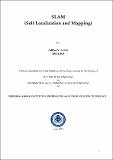| dc.contributor.advisor | Dubey, Rahul | |
| dc.contributor.author | Lodha, Aditya V. | |
| dc.date.accessioned | 2017-06-10T14:40:25Z | |
| dc.date.available | 2017-06-10T14:40:25Z | |
| dc.date.issued | 2013 | |
| dc.identifier.citation | Lodha, Aditya V. (2013). SLAM (Self localization and mapping). Dhirubhai Ambani Institute of Information and Communication Technology, vii, 47 p. (Acc.No: T00388) | |
| dc.identifier.uri | http://drsr.daiict.ac.in/handle/123456789/425 | |
| dc.description.abstract | A fundamental competence of any mobile robot system is the ability to remain localized while operating in an environment. For unknown/partially known environments there is a need to combine localization with automatic mapping to facilitate the localization process. The process of Simultaneous Localization and Mapping (SLAM) is the topic of this thesis.
SLAM is a topic that has been studied for more than two decades using a variety of different methodologies, yet it deployment has been hampered by problems in terms of computational complexity, consistent integration of partially observable features, divergence due to linearization of the process, introduction of topological constraints into the estimation process, and efficient handling of ambiguities in the data-association process.
Purpose of this study is to understand the basic problem of SLAM. Using ultrasonic sensor and wheel encoder only, implementation of SLAM is approached. This is a very basic method of SLAM, but it is necessary to understand the problem of SLAM. The method used in this study is very simple to understand and is based on modified SLAM [3]. | |
| dc.publisher | Dhirubhai Ambani Institute of Information and Communication Technology | |
| dc.subject | Self-Localization and Mapping | |
| dc.subject | SLAM | |
| dc.subject | Electronic Engineering | |
| dc.classification.ddc | 629.892 LOD | |
| dc.title | SLAM (Self localization and mapping) | |
| dc.type | Dissertation | |
| dc.degree | M. Tech | |
| dc.student.id | 201111009 | |
| dc.accession.number | T00388 | |

